|
|
|
 |
|
|
|
|
|
|
Welcome to Spaightwood Galleries, Inc.
120 Main Street, Upton MA 01568-6193; 800-809-3343; email: spaightwood@gmail.com
You can follow us on Facebook at http://www.facebook.com/andrew.weiner.16
and http://www.facebook.com/pages/Spaightwood-Galleries-Inc/122951564441757
Biblical Subjects / Mythological Subjects / Allegorical Subjects / Historical Subjects
|
|
|
|
|
|
|
|
|
|
|
This show was born in a discussion about a passage in Sir Philip Sidney's Old Arcadia (1579-80), in which the narrator describes the virtuous and virginal heroine as wearing a dress "so near nakedness that one might well discern part of her perfections, and yet so apparelled as did show that she kept the best store of her beauties to herself; her excellent fair hair drawn up into a net made only of itself (a net indeed to have caught the wildest disposition); her body covered in a light taffeta garment so cut as the wrought smock came through it in many places (enough to have made a very restrained imagination to have thought about what was under it)." One of the thoughts this passage inspired was that essentially women were a mystery to men—including artists: creatures able to tame the wildest and make wild the tamest, perhaps simultaneously! We began to wonder about the traditional disjunctive classification of women as either saints or sluts, a distinction reified in a 1990 show at The National Gallery of Art, Eva / Ave: Women in Renaissance and Baroque Prints by H. Diane Russell. In the passage quoted above from The Old Arcadia, it is not women but the imaginations of men that seem to be the issue. The same situation seems often the case in Renaissance prints and drawings as well. When we see a Susanna or a Bathsheba innocently bathing, a violated Lucrece, or a penitent Mary Magdalene, the mind registers one understanding of the scene even as the imagination is invited to create another. Thus was born a curiosity about the depictions of women in a wide variety of sixteenth and seventeenth-century prints and drawings presenting women in the contexts of biblical history, secular history, mythology, "real life," and life moralized.
This show is the offspring of that curiosity. In an earlier version of this show, we presented works ranging from a series of woodcuts published in Venice in 1497 and 1501 as illustrations to Ovid's Metamorphoses as well as a later set made after drawings by Hendrik Goltzius about 100 years later; prints taken from two sets illustrating the Heroines of the Old and New Testaments (including Tamar seducing her father-in-law to force him to allow her to marry one of her dead husband's brothers as the law commanded, Rahab, a Canaanite prostitute who shelters Joshua's spies and aids in the fall of her city to the people of Israel, Judith, a virtuous Israelite who seduces an Assyrian general in order to behead him and throw his army into disorder at the discovery of his headless body, and Mary Magdalen, a prostitute who becomes one of the most passionate disciples of Jesus); women depicted as allegorized virtues or vices, and women taken from history or from present-day life.
“Images of Women in Old Master Prints and Drawings / Images by Women in Old Master Prints." The show that wouldn't come off the walls is back in its boxes. Our longest running exhibition was also our best seling show ever. This show began with fifteen scenes featuring women acting or suffering from Albrecht Durer's Small Woodcut Passion ranging from the Fall to the Nativity, from the Passion to the Resurrection, and on to Pentecost and the Last Judgment (links to follow soon). We then focused on a number of scenes featuring the Virgin Mary, the Holy Family, with added angels and saints, Magi, and shepherds, including drawings by Paolo Veronese, an anonymous Venetian Birth of the Virgin, and works by Annibale Carracci (a Pentecost clearly based upon Durer's version from the Small Woodcut Passion, Pier Francesco Mola, Simone Cantarini, . a Lamentation in the Style of Federico Zuccaro, and two 17th-century Flemish models for altarpieces. Next came 10 works by Dürer, including 5 from The Life of the Virgin, 3 from the Small Woodcut Passion, 1 from the Engraved Passion, and The Madonna with the Swaddled Infant. We then presented a synoptic history from the creation of Adam and Eve to the Last Judgment by artists including Lucas van Leyden (3), Jan Sadeler (4), and Jan Saenredam (2). After six works by German (Hans Sebald Beham and Georg Pencz) and Netherlandish masters (Master DD) featuring David watching Bathsheba bathe, Esther and Ahasuerias, Lot and his Daughters (2), Judith (2), and Susanna and the Elders, we focus on the story of Judith in a drawing (Luca Cambiaso) and 9 prints by Hans Sebald Beham, a Raimondi School artist c. 1520 after Mocetto after Mantegna, Parmigianino, Aegidius Sadeler, Jan Saenredam, Jean Cousin the Younger, and etchings after Domenichino and Guido Reni. The Sacred part of the show ends (mostly) with two drawings (Etienne Parrocel and a drawing after Agostino Carracci's engraving after Veronese) and an etching (c. 1550) by Giacomo Francia featuring Mary Magdalene, a very powerful Pieta drawn after an engraving by Agostino Carracci after a painting by Veronese as well as works by Lucas van Leyden (a hand-colored impression of one of his large engravings, Golgotha), Dürer (a proof before the 1511 Large Woodcut Passion of The Harrowing of Hell, and a large engraving by Willem van Swanenburgh after Paulus Moreelse's Resurrection.
Most of the rest of the show is devoted to depictions of women in Roman history (Lucretia, Cimon and Pero), allegory (Beham's Melancholia and Iusticia, Pencz' Sloth), and mythology, including drawings of Ceres by Federico Zuccaro, and an anonymous 17th-Century Italian artist, the Rape of Europa, Schiavone's Dido learning of the flight of Aeneas, and engravings by Giorgio Ghisi (4 featuring Venus, Cupid, Vulcan, and Juno), Jan Saenredam (9, all after drawings by Hendrik Goltzius), and a chiaroscuro woodcut by Paulus Moreelse showing Cupid dancing with some nymphs. A few religious old master drawings crept in on the Pagan side as well, including drawings by Abraham Bloemaert (Mary Magdalene), a Bolognese drawing of Lot and his Daughters, Simone Cantarini's St. Apollonia, a drawing of Susannah and the Elders by Bernaert van Orley, and a drawing of Sarah overhearing the angels tell Abraham that she will have a child after an engraving by Jacob Matham after a drawing by his stepfather Hendrik Goltzius. In addition to a Venetian drawing of A woman looking over her shoulder and a drawing by Alessandro Casolani featuring Studies of reclining women which made one owner of the sheet write "Michelangelo" on the verso, possibly remembering Michelangelo's sculpture of Night in the Medici Chapel in Florence.
There are also several larger pieces on this side of the exhibit, including engravings after Titian's "Venus and Adonis," Michelangelo's "Fall of Phaeton," Aenea Vico's "Battle of the Centaurs and Lapiths" (which is more likely a "Rape of the Sabine Women," Durer's "Hercules conquering the Molionide Twins," and Gianbattista Franco's "Hercules killing Nessus as he tries to abduct Deianeira." Rounding out this second side of the gallery are drawings by Perino del Vaga (Fortitude) and Giulio Romano (Justice). Giulio and Perino were both assistants of Raphael and were working on a room in the Vatican that, according to Vasari, was to contain paintings of Fortitude and Justice. There is also a very beautiful red chalk drawing by Matteo Rosselli of a mother and child asleep in a landscape (see above).
Slightly pushing our boundaries, there are also 5 18th-Century works, an etching of Diana and Endymion by Gerard de Lairesse and 4 red chalk and red and black chalk studies of women by Jean de Neufforge. The show concludes with 14 engravings by Hans (Jan) Collaert after Maarten de Vos of Women of the Old Testament and 2 by Carel de Mallery of Women of the New Testament.
|
|
|
|
|
|
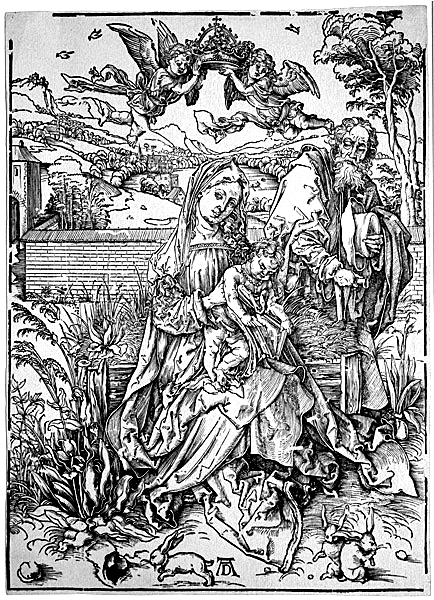 |
|
Holy Family with the three hares (Bartsch 106, Strauss 36, Meder 312h/i). Original woodcut, c. 1496. One of Dürer's earliest major prints, this work was one of the first to reveal his genius. The three rabbits add a playful touch to this scene of domesticity. Our's is an impression of c. 1580 of a work that has been praised by Wolfflin as "radiant" in its revelation of "the abundance of life." A clear impression that is still printing quite well. Image size: 392x280mm. Price: Please call or email for current pricing information.
|
|
|
|
 |
|
Apocaliptis cum figuris / The Apocalypse with illustrations (Bartsch 60, Strauss 158, Meder 163). Original woodcut, 1511. Original woodcut for the 1511 Latin edition of The Apocalypse, the first to contain this woodcut of St. John's Mystical Vision of the Virgin and Child. Sheet trimmed just outside the text on the verso. One of Durer's masterpieces, here in a superb impression of the first priting of the woodcut. Image size: 361x228mm. Price: SOLD.
|
|
|
|
|
|
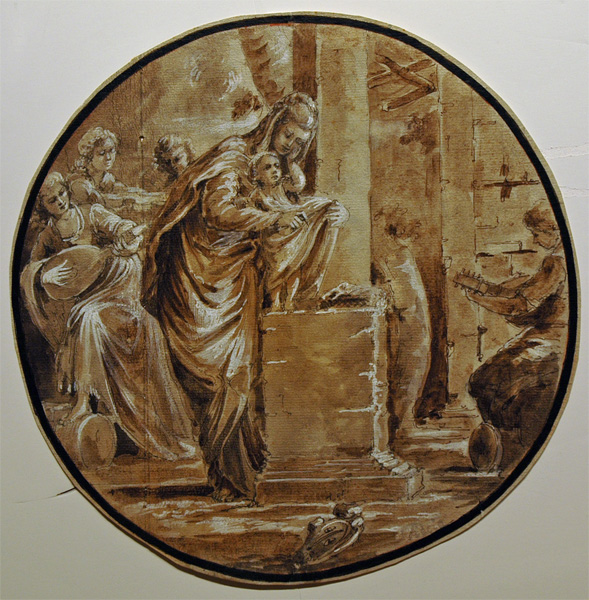 |
|
|
Veronese, Virgin and Child with Musical Angels in the Wilderness. Pen and brown ink and wash with white lead heightening. One of a group of chiaroscuro drawings that Veronese, according to Cocke, executed from the late 1550s to the early-1560s (see Cocke, Veronese's Drawings, p. 71), but which may have continued in technique if not in spirit to the late 1570s, according to Annalisa Scarpi's annotation on a drawing in pen and brown ink with white lead heigtening that Veronese prepared in connection with his Triumph of Venice for the ceiling of the Sala del Maggior Consiglio above the Doge's throne commissioned 1579 and completed by 1582 (see Giandomenico Romanelli et al, Veronese: Gods, Heroes and Allegories [Milan: Skira, 2004], p. 140; see also p. 142, where Scarpi dates another of the chiaroscuro drawings, The Triumph of Fame over Evil to the 1580s).
Cocke's comments on these chiaroscuro drawings are useful: "The independent chiaroscuro drawings were among the most admired of Veronese's drawings, being the only ones mentioned by his first biographer Ridolfi in 1648. Ridolfi's enthusiasm is understandable, for they were planned as independent works in preparatory drawings and executed with a brilliance and fluidity in the white heightening that was copied but never equalled. Veronese here turned to an older tradition of Venetian drawing with a sense of invention in conventional subjects, both religious and allegorical and in unusal variations on well-established themes (p. 71).
Our drawing is on cream laid paper with a watermark close to Briquet 7112 (Salerno 1570) and 7113 (Ferrarra 1570) and a worn collector's mark on verso. There is a variant of the drawing in the Louvre titled "Pittura Quarta," depicting the Virgin and Child surrounded by six angels (see Cocke, Veronese's Drawings, p. 76). The Louvre drawing, which suffers from fading due to over-exposure in the 19th century, presents the Virgin and the standing Child at the same column base. The Virgin holds the same "strange implement (a Pair of tongs?)" while Jesus reaches up to caress her face. On the left side, three musical angels in similar positions in a similar arrangement are serenading them; on the right, three more angels play for her, one of whom, seated playing a lute is close to ours, the only one on the right side of our drawing. In the background are the ruins of a building (perhaps the manger). Our drawing is circular, the Louvre's is rectangular. Both are beautiful and well-executed drawings, ours, perhaps a presentation drawing, seems more brilliant, finished and assured. According to Cocke (p. 77, note 7), the Louvre's Veronese remained in Veronese's studio during the artist's lifetime: "That it remained in the studio may be confirmed by the painting in the collection of Antonio Zecchini in Pescara, which measured about the same size as the drawing and was, to judge from the engraving by Diogini Valesi, a studio derivation from the drawing." Our Veronese, by contrast, shows precisely the characteristics that Cock praises: "independent works in preparatory drawings and executed with a brilliance and fluidity in the white heightening that was copied but never equalled."
One of Veronese's small ink drawings sold at auction at Chirstie's London on Dec. 5, 2006 for £180,000 (then Please call or email for current pricing information). We offer ours for a bit less than half that price. Image size: 285mm diameter. Price: Please call or email for current pricing information.
|
|
|
 |
|
|
|
Hans Sebald Beham (German, 1500-1550), Judith and Her Servant Standing (Bartsch. 10, Pauli 11). Original engraving, c. 1532. A very good early 16th-century impression with inky plate edges and thread margins. Rare in this condition. Illustrated in Eva / Ave: Women in Renaissance and Baroque Prints. Image size: 108x69mm. Price: Please call or email for current pricing information.
|
|
|
|
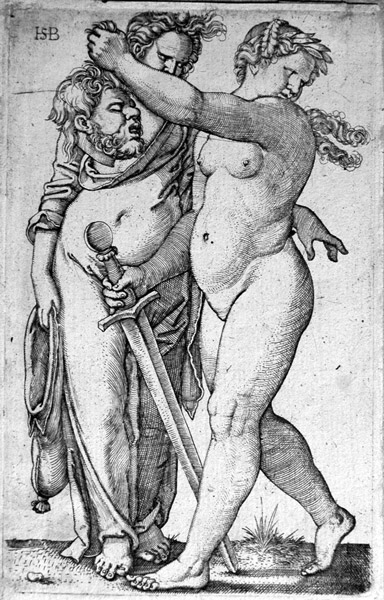 |
|
Hans Sebald Beham (German, 1500-1550), Judith and Her Servant Walking to the left (Bartsch 11, Pauli 12,). Original engraving, c. 1531. A very good early impression of this scarce print on thin cream laid paper. Very rare. Small margins. Ex-collection Fürstlich Waldburg Wolfeggisches Kupferstichkabinett (Lugt 2542 verso). Illustrated in Eva/Ave: Images of Women in Renaissance Prints (National Gallery of Art, 1990), plate 26. Image size: 108x69mm. Price: Please call or email for current pricing information.
|
|
|
|
|
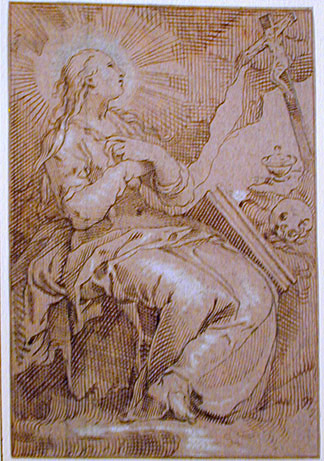 |
|
Abraham Bloemaert (Dutch, 1566-1651), attributed, Penitent Magdalene. Pen and brown ink on gray paper heightened with white. In addition to his very successful career as a painter, Bloemaert was a prolific and talented draftsman who executed over 1500 drawings of various types including nature studies, preparatory studies for paintings, and many very detailed drawings that served as models for prints. His contemporary Carel Van Mander in his book about the state of Netherlandish art in the seventeen century praised Bloemaert for his "very nice manner of drawing and handling the pen, and he obtained an unusual effect by adding a few succulent touches of color." Before 1595, Bloemaert's work shows very abrupt separations between the foreground and the background; our drawing makes a seamless transition and should be dated later, Bloemaert was a devout Catholic one of whose sisters was a nun. He was awarded several important commissions by the Catholic Church. This study of Mary Magdalene is more likely to have been executed with an eye toward a Catholic audience. Image size: 130x88mm. Price: Please call or email for current pricing information.
|
|
|
|
|
 |
|
|
Matteo Rosselli (Italian, 1578-1651), attributed), Woman and child asleep in a landscape. Red chalk on cream laid paper, c. 1610. Image size: 285x443mm. Price: Please call or email for current pricing information.
|
|
|
|
|
|
|
|
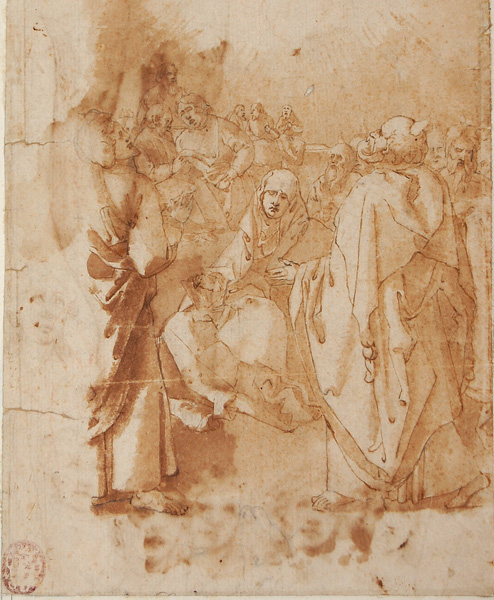 |
|
Paolo Veronese, attributed, Pentecost. Pen and brown ink and wash on cream laid paper, c. 1545-55?. Old collector's mark lower left. On the verso are 6 studies of heads looking upwards and a study of feet and legs, possibly a study for a crucifixion. The heads show through on the left side and the bottom of this sheet. If one compares this drawing with Durer's Pentecost in the Small Woodcut Passion, it is clear that Veronese was working with it close at hand. Image size: 215x165mm. Price: Please call or email for current pricing information.
|
|
|
|
 |
|
Albrecht Durer (Nuremburg, 1471-1528), Pentecost (Bartsch 51, Strauss 135) Original woodcut, c. 1510 for the Small Passion. In 1844 plaster casts were made from Durer's original woodblocks for the Small Woodcut Passion, which had just been acquired by the British Museum. From these casts, metal plates were made and a small edition produced. Our impression is from this edition. Annibable Carracci used this woodcut as a model for his drawing of the Pentecost (see immediately above). Image size: 123x95mm. Price: Please call or email for current pricing information.
|
|
|
|
|
 |
|
|
Giorgio Ghisi (Italian, 1520-1582), Venus, Cupid, and Vulcan Seated on a Bed (Bartsch 35, Boorsch, Lewis, and Lewis 18 iii). Engraving after Perino del Vaga, c. 1550. Our impression is from an edition published in Rome in the 17th Century. Venus lectures Cupid while two other putti surround Venus. Signed "GMF" [Girgio Mantua Fecit] on the tablet on the edge of the first stair at right. Image size: 290x205mm. Price: Please call or email for current pricing information.
|
|
|
|
 |
|
Giorgio Ghisi (Italian, 1520-1582), Venus and Adonis (Bartsch 42, Boorsch, Lewis, and Lewis 42 vi/vii). Engraving after Teodoro Ghisi, Giorgio's younger brother, c. 1570. Our impression is from an edition published in Rome in the 17th Century. Inscribed Teodoro Ghisi In on the tablet at left and GMF by the rocks beneath the putto playing with a rabbit left center. A good impression with wide margins on laid paper. The most important of Ghisi's 65 prints. Ex collection Kunsthalle, Hamburg (L. 685 & 12328). Image size: 312x224mm. Price: Please call or email for current pricing information.
|
|
|
|
|
|
 |
|
|
|
Venus and Mars with Cupid (Bartsch 104). Engraving after Peter Isaacsz, 1604, signed in the plate ltop left: "Petrus Isach pinxit / Ioan Saendredam sculps. et excu. / 1604." Ours is a good impression (sharp but light) on laid paper with small margins outside the platemark. Image size: 155x208mm. Price: Please call or email for current pricing information.
|
|
|
|
|
|
Spaightwood Galleries, Inc.
To purchase, call us at 1-800-809-3343 (1-508-529-2511 in Upton MA & vicinity) or send an email to spaightwood@gmail.com. We accept AmericanExpress, DiscoverCard, MasterCard, and Visa.
For directions and visiting information, please call. We are, of course, always available over the web and by telephone (see above for contact information). Click the following for links to past shows and artists. For a visual tour of the gallery, please click here. For information about Andy Weiner and Sonja Hansard-Weiner, please click here. For a list of special offers currently available, see Specials.
Visiting hours: Noon to six Saturdays and Sundays; other times by arrangement. Please call to confirm your visit. Browsers and guests are welcome.
|
|
|
|
|
|
|
|
|
|
|
|
|
|
|
|
|
|
|
|
|
|
|
|
|
|
|
|
|
|
|
|
|
|
|
|
|
|
|
|











